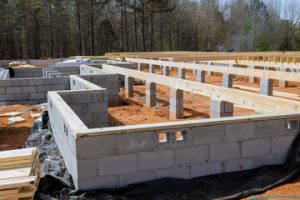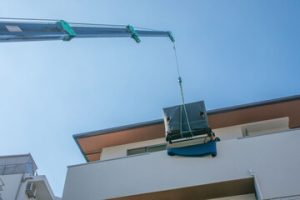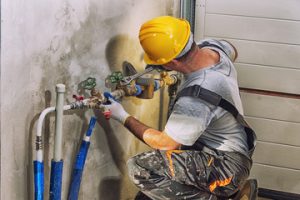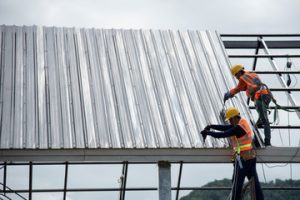Gutters Gainesville FL protect your home from a variety of issues, from water damage and mold and mildew to basement and crawl space flooding. They do this by directing rainwater away from the house through gutter downspouts.
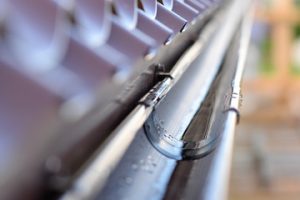
Clogged gutters with leaves, twigs, pine needles and other debris create breeding grounds for unwanted pests, as well. Gutters help keep your property clean and sanitary, reducing the risk of mold spores that can diminish indoor air quality.
Gutters are vital to your home because they direct rainwater away from your house, protecting the foundation and preventing issues like basement flooding and mold growth. Without gutters, water would pour right off the roof and down the siding or puddle near the foundation, where it could seep into the walls and cause rotting and structural damage. However, a well-installed and maintained gutter system keeps water from pooling near the foundation, allowing it to flow down through the downspouts and into an underground drainage system or landscaping.
Without a gutter system, moisture that accumulates around your home can cause problems including rotted siding and moss, mildew and mold growth, foundation cracks, basement flooding, and water damage to windows, doors and insulation. In fact, studies have shown that homes without gutters are 70% more likely to experience water damage, mold growth and basement flooding than those with properly functioning and maintained gutter systems.
When gutters aren’t working properly, they’re clogged with leaves, branches and debris, causing them to overflow during heavy rainfall and back up onto the roof. Over time, this can lead to roof damage, shingle deterioration, wood damage to fascia boards and soffits, and damage to the masonry of the foundation. In addition, standing water can attract bugs and rodents that can infiltrate your home through openings in the siding, windows and other areas.
A good gutter system is properly pitched, meaning that the troughs have a slight slope toward the downspouts. If the pitch is too low, water pools in the gutters, resulting in clogs and overflow, while if it’s too high, the extra weight can make the gutters pull away from the fascia boards. A professional can ensure that your gutters are pitched correctly to prevent clogs, overflow and foundation damage.
Gutters are an inexpensive way to protect your home from serious and costly damage. When homeowners invest in gutter maintenance, they not only save money on expensive repairs, but also increase their home’s value by adding curb appeal and ensuring that buyers aren’t turned off by the presence of a damaged, worn down or non-functioning gutter system.
Prevents Soil Erosion
Regardless of whether you have a flat or sloped roof, gutters prevent soil erosion around your home by channeling water away from the foundation. When soil erosion occurs, it exposes the bottom layers of your home to the elements, leading to foundation damage and other structural issues that can cost thousands of dollars in repairs and renovations. Gutters also help protect landscaping and garden beds, where water runoff can wash away mulch and sand, damaging the roots of your plants and causing them to die.
One of the most significant long-term benefits of gutters is that they protect your foundation from shifting and cracking. Foundation problems can be caused by a number of factors, including improper water shedding and ground settlement, but most commonly because of a lack of gutters. Gutters allow rainwater to easily flow away from the foundation, preventing excess moisture around windows and doors that can lead to wood rot, mildew, and mold.
Gutters also prevent soil erosion that affects your garden and landscaping, which can be a costly problem for homeowners. When soil erosion occurs, it can wash away nutrient-rich topsoil, leaving bare spots in your yard and landscape. Gutters, paired with downspout extensions, can help keep the soil around your home healthy and stable by directing water flow away from the foundation and into an irrigation system or rain garden.
A properly working gutter system is essential for a healthy home, but they can’t do their job without regular maintenance. Clogged gutters can cause overflowing and leaking, which can lead to costly water damage. If you notice that your gutters are clogged, try flushing them with a hose and removing any leaves or debris that have built up in the eavestroughs.
Gutters also prevent the formation of ice dams in colder climates, where melted snow refreezes on the edge of your roof and leads to water leaks in basements and crawl spaces. A reliable gutter system channels rainwater and melted snow away from the roof, prolonging the life of your shingles and reducing the risk of expensive repair work.
Prevents Mold and Mildew
Mold and mildew aren’t just unsightly; they can also be unhealthy for you and your family. They thrive in damp, organic settings and can release spores that trigger allergic reactions or respiratory issues in people with sensitive systems. Gutters help to keep these problems at bay by ensuring that rainwater isn’t allowed to pool near the foundations of your home or leak into the basement.
In addition, gutters help to prevent the accumulation of rainwater around your home’s exterior walls, which can lead to structural damage and cracking over time. When gutters are clogged, water is more likely to seep under the shingles and into the wood siding of your house, creating a moist environment that’s perfect for mold and mildew to grow in. Clogged gutters can also impede proper drainage, which can cause moisture to build up in the fascia and soffit boards that support your roof. Regular gutter cleaning minimizes the risk of moisture accumulation and protects your roof’s integrity, extending its lifespan.
Gutters and downspouts are designed to efficiently channel water away from your roof, fascia, and foundation. This minimizes the risk of standing water, which breeds mold and mildew, as well as other unwanted pests. Inspecting your gutters for damage and ensuring that they are positioned at optimal angles helps to further reduce the likelihood of stagnant water. In addition, regularly trimming overhanging trees helps to keep debris from falling into your gutters.
Mold spores in your gutters can also find their way into living spaces and can trigger indoor air quality problems, such as musty odors or visible water stains on walls and ceilings. This is especially dangerous for individuals with allergies or respiratory issues, and can aggravate symptoms in children and elderly people.
By removing clogged gutters and promoting good indoor air quality, you can prevent these issues and protect your family’s health and well-being. If you’re thinking about selling your home in the future, keeping your gutters clean can also increase its value and make it more appealing to potential buyers.
Prevents Crawl Space Issues
Crawl spaces house valuable equipment and personal items, as well as vital home utilities. It’s crucial that the space remains dry to prevent damage and to protect people living in the home. Gutters are a key component to this goal. Gutters catch the immediate water flow and channel it away from foundation areas, preventing crawl spaces from becoming damp. They also prevent crawl spaces from being affected by basement and foundation issues.
Crawl space moisture problems can be caused by many things, from plumbing leaks to poor soil drainage. When a crawl space becomes damp, it creates an environment hospitable to mold growth, mildew and rotting wood. Ultimately, these issues can lead to structural instability and compromise the integrity of the home. The most common causes of crawl space moisture are related to drainage issues, and addressing them early on can prevent serious problems later.
Without gutters, rainwater pools around the foundation of a home and seeps into the ground. This can wash away the soil and cause settling of the foundation. It can also exert pressure on the foundation walls that can crack and damage the basement or crawl space.
When a gutter system is functioning properly, it channels rainwater into downspouts that carry the water away from the home. Downspouts are typically directed into an underground drain or into an extension that carries the water at least 4 to 6 feet away from the foundation area of the home. This helps to keep the foundation and crawl space drier, decreasing the chances of water issues, rot and mold.
In order to ensure that your gutter system is working effectively, it’s a good idea to hire professionals for regular maintenance. They can help to inspect the system and check that the downspouts are not clogged with leaves and other debris. They can also assist with optimizing crawl space ventilation to prevent moisture intrusion into the space. This is important because too much moisture can increase energy costs as it takes more energy to heat and cool a damp space.
